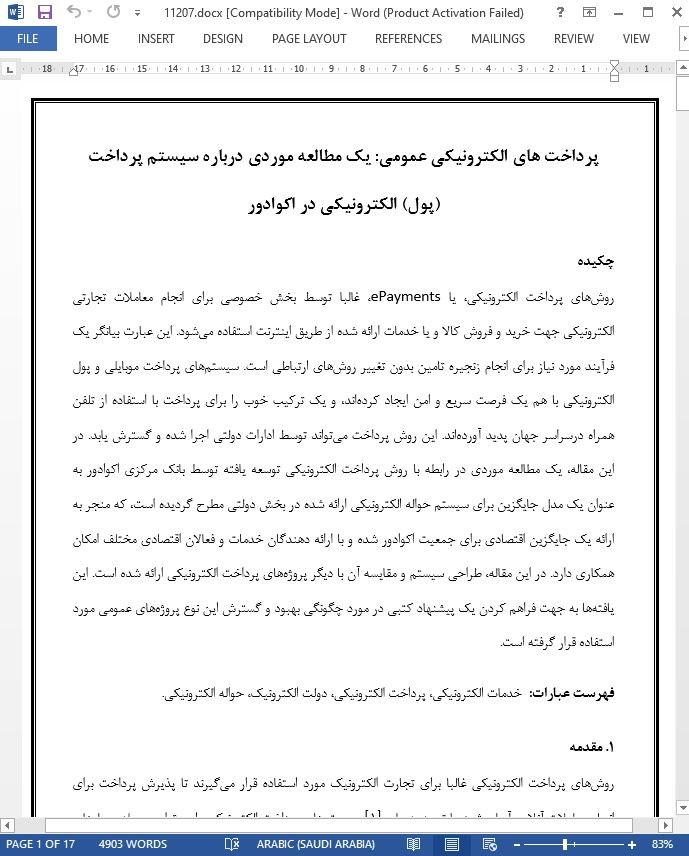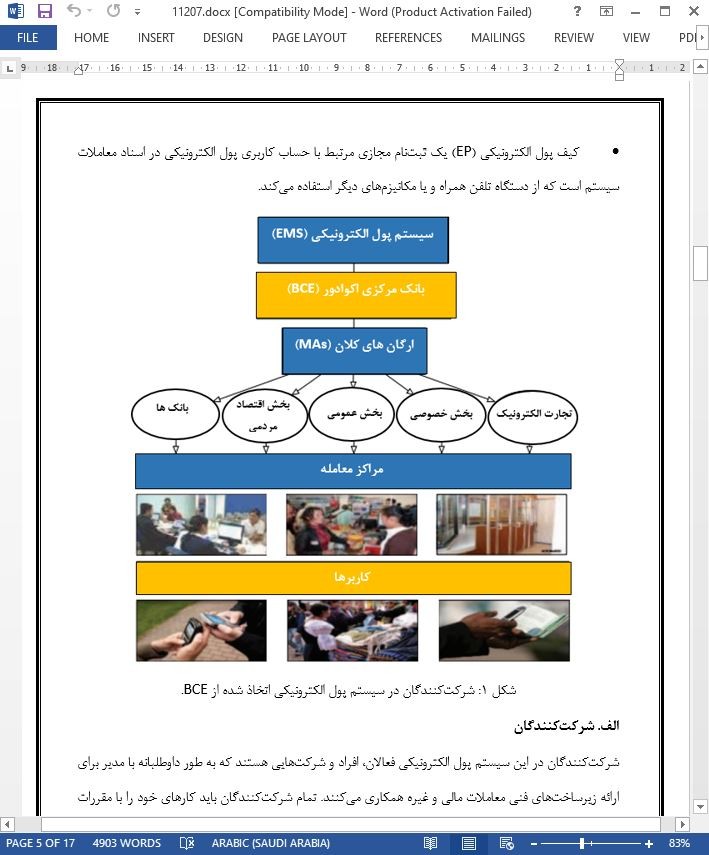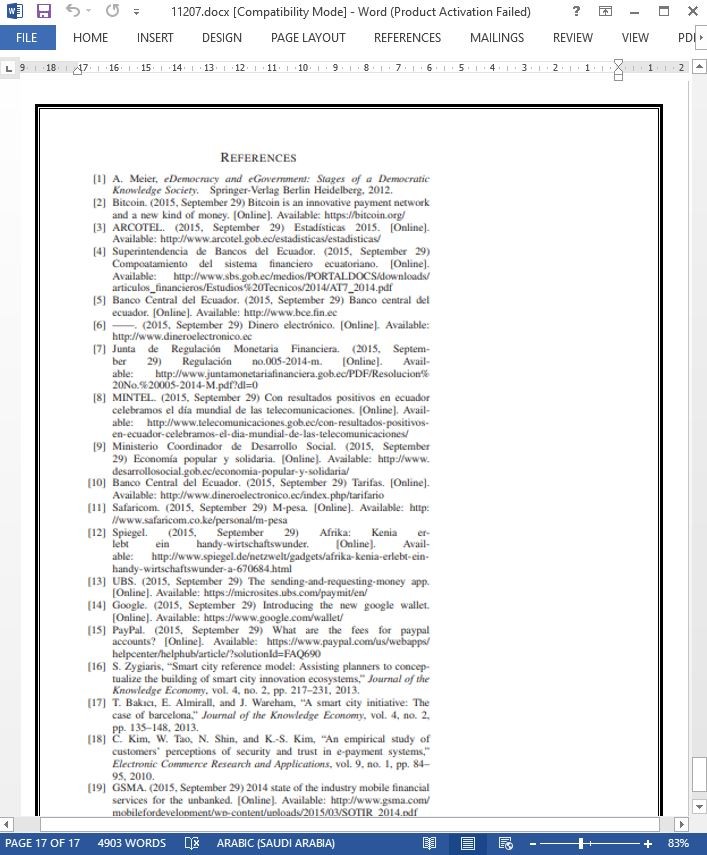
پرداخت های الکترونیکی عمومی
چکیده
روش های پرداخت الکترونیکی، یا ePayments، غالبا توسط بخش خصوصی برای انجام معاملات تجارتی الکترونیکی جهت خرید و فروش کالا و یا خدمات ارائه شده از طریق اینترنت استفاده می شود. این عبارت بیانگر یک فرآیند مورد نیاز برای انجام زنجیره تامین بدون تغییر روش های ارتباطی است. سیستم های پرداخت موبایلی و پول الکترونیکی با هم یک فرصت سریع و امن ایجاد کرده اند، و یک ترکیب خوب را برای پرداخت با استفاده از تلفن همراه درسراسر جهان پدید آورده اند. این روش پرداخت می تواند توسط ادارات دولتی اجرا شده و گسترش یابد. در این مقاله، یک مطالعه موردی در رابطه با روش پرداخت الکترونیکی توسعه یافته توسط بانک مرکزی اکوادور به عنوان یک مدل جایگزین برای سیستم حواله الکترونیکی ارائه شده در بخش دولتی مطرح گردیده است، که منجر به ارائه یک جایگزین اقتصادی برای جمعیت اکوادور شده و با ارائه دهندگان خدمات و فعالان اقتصادی مختلف امکان همکاری دارد. در این مقاله، طراحی سیستم و مقایسه آن با دیگر پروژه های پرداخت الکترونیکی ارائه شده است. این یافته ها به جهت فراهم کردن یک پیشنهاد کتبی در مورد چگونگی بهبود و گسترش این نوع پروژه های عمومی مورد استفاده قرار گرفته است.
1. مقدمه
روش های پرداخت الکترونیکی غالبا برای تجارت الکترونیک مورد استفاده قرار می گیرند تا پذیرش پرداخت برای انجام معاملات آنلاین آسان شود. با توجه به مایر [1]، سیستمهای پرداخت الکترونیکی را می توان بوسیله معیارهای مختلفی طبقه بندی کرد: معیار طبقه بندی اول مقدار پول قابل انتقال است (به عنوان مثال، پرداخت پیکو، پرداخت های میکرو و ماکرو). معیار طبقه بندی دوم وضعیت کاربران بانام و بی نام است. این طبقه بندی برای کاربرانی است که نمی خواهند شناسایی شوند. طبقه بندی سوم بر اساس زمان پرداخت الکترونیکی است. به این منظور دسته بندی زیر توسط مایر ارائه شده است [1]: پیش پرداخت (مثلا، www.GeldKarte.de و www.paysafecard.com)، پرداخت در هنگام خرید (به عنوان مثال، www.paypal.com و www.pago.de)، و پرداخت اعتباری یا بعد از خرید (به عنوان مثال، www.clickandbuy.de). راه حل های نوآورانه دیگری نیز ممکن است در بازار وجود داشته باشد.
7. نتیجه گیری
سیستمهای پرداخت متفاوتی وجود دارد. بیشتر آنها توسط بخش خصوصی اداره می شود. نمونه مربوط به اکوادور یکی از اولین موارد قانونی است، که برای تمام فعالان اقتصادی قابل استفاده می باشد. سیستم پول الکترونیکی به طور کامل برای همکاری بخش های خصوصی و دولتی باز است که از این طریق بازده سیستم پول فعلی بهبود می-یابد و اثرات مثبتی بر شمول مالی و اقتصادی دارد. این سیستم محبوب و همگانی است [9]، هزینه معاملات (زمان، پول و امنیت) را کاهش می دهد، به خدمات مالی، اطلاعات و وضع بازار دسترسی دارد. این سیتم به نفع بخش کسب و کار و کارآفرینان است، هزینه های عملیاتی، درآمد، مدیریت پول نقد، جریان پول نقد، و مدیریت موجودی را بهبود می دهد.
Abstract
Electronic payment methods, or ePayments, are frequently used by the private sector for eCommerce transactions for buying and selling goods or services offered through the Internet. This term describes the process needed to carry out the supply chain without changing media channels. Mobile payment systems and electronic cash have emerged as a quick and safe opportunity, which draws high penetration and use of cell phones for payments in the world. This type of payment method can also be extended and implemented by public administrations. In this paper, a case study on an electronic payment method developed by the Central Bank of Ecuador is presented as an alternative model to the electronic cash system offered with the public sector, seeking to provide the Ecuadorian population with an alternative for economic inclusion and allowing interoperability with different service providers and economic actors. In this work, the design of the system and a comparison with other electronic payment projects is presented. The findings are used to provide recommendations on how to enhance and replicate the development of this type of public projects.
I. INTRODUCTION
Electronic payment methods are frequently used for eCommerce to facilitate the acceptance of payment for online transactions. According to Meier [1], electronic payment systems can be classified by different criteria: A first classification could be made by the amount of money to be transferred (e.g., pico payment, micro payment, and macro payment). A second classification criterion could be the status of anonymous and non anonymous users; the latter provides payments for users that do not want to be identified. A third classification of ePayment methods is made by the time of the payment. For that purpose, three categories have been proposed by Meier [1]: prepay (e.g., www.GeldKarte.de and www.paysafecard.com), pay now (e.g., www.paypal.com and www.pago.de), and pay later (e.g., www.clickandbuy.de). Other innovative solutions that were not able to establish themselves in the market have existed.
VII. CONCLUSIONS
Several types of mobile payment systems exist. Most are administered by private actors. The case of Ecuador is the first one involving law enforcement, is inter-operational, and is open to use by all actors of the economy. The electronic cash system is completely open to interoperate across the private or public sectors to improve the efficiency of the current monetary system, with positive effects on financial and economic inclusion. It contributes to the popular and solidarity economy [9] with reduced transaction costs (time, money and security), access to financial services, and information and market transparency. It benefits the business sector and entrepreneurs, reducing operating costs, revenue, cash management, cash flow, and inventory management, among others.
چکیده
1. مقدمه
2. آثار قبلی
3. سیستم حواله الکترونیکی
الف. شركت كنندگان
ب. عملکرد
ج. اجرت و کمیسیون (هزینه کار)
4. مقایسه با دیگر پروژه های پرداخت الکترونیکی
5. دورنما
6. پیشنهادات
7. نتیجه گیری
Abstract
I. INTRODUCTION
II. BACKGROUND
III. THE ELECTRONIC CASH SYSTEM
A. Participants
B. Operability
C. Fees and Commissions
IV. COMPARISON WITH OTHER EPAYMENT PROJECTS
V. OUTLOOK
VI. RECOMMENDATIONS
VII. CONCLUSIONS
- اصل مقاله انگلیسی با فرمت ورد (word) با قابلیت ویرایش
- ترجمه فارسی مقاله با فرمت ورد (word) با قابلیت ویرایش، بدون آرم سایت ای ترجمه
- ترجمه فارسی مقاله با فرمت pdf، بدون آرم سایت ای ترجمه



